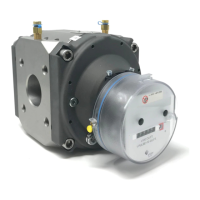1. General Information
This manual covers the installation, operation and maintenance
for the Elster Instromet RABO Rotary Meter. Refer to EAM-TB5900
for additional information.
2. Intended Use and Application
Elster RABO meters are suitable for measuring most types of
clean, dry, non-corrosive common gases. They are NOT intended
for use on biogas, sewage gas, oxygen, acetylene or liquids of
any kind. Product life and measurement accuracy can be affected
by contamination in the gas stream. Periodic servicing will prolong
the life and performance of the meter.
3. Operating Principle
The RABO meter utilizes positive displacement principle of
operation which makes volumetric measurements by displacing
finite volumes of gas. The positive displacement occurs within
a cavity formed between the meter’s internal housing and its
rotating impellers. The counter-rotating “figure-8” impellers [Figure
1] turn as a result of pressure drop across the meter’s inlet and
outlet created as downstream gas is consumed. The rotating
impellers separate the flowing gas into small, finite volumes
and are counted using a mechanical index. The RABO meter
has no wearing parts because precision clearances between
the impellers and meter body are maintained by timing gears,
which are designed to enhance long term accuracy. Combining
adequate filtration and periodic maintenance, a RABO meter will
remain accurate over many years.
As the left impeller rotates
toward the vertical position,
gas enters the cavity created
between the impeller
and the housing.
When the left impeller
reaches the vertical
position, a nite volume
of gas is captured in the
left cavity.
As the impellers continue
to turn, the volume of gas in
the left cavity is discharged.
Simultaneously, gas is
entering the space between
the right impeller and
housing.
After further rotation, the
right impeller becomes
vertical and a nite volume
of gas is captured in the
right cavity.
Figure 1. Operating Principle
Table of Contents
1. General Information 2
2. Intended Use and Application
2
3. Operating Principle
2
4. Receiving, Handling and Storage
3
5. Installation
3
6. Start-up/Commissioning
5
7. Decommissioning and Removal
5
8. Inspection and Maintenance
5
9. Testing
5
10. Technical Data
7
11. Index
8
12. Pulser 10
13. Thermowell 11
14. Auxiliary Equipment Mounting 11
15. Troubleshooting 11
RABO
®
Rotary Gas Meter
RABO
®
Rotary Gas Meter 02 Elster Instromet
RABO
®
Rotary Gas Meter
1. General Information 3
2. Intended Use and Application 3
3. Operating Principle 3
4. Receiving, Handling and Storage 4
5. Installation 4
6. Start-up/Commissioning 6
7. Decommissioning and Removal 6
8. Inspection and Maintenance 6
9. Testing 6
10. Technical Data 8
11. Index 9
12. Pulser 11
13. Thermowell 12
14. Instrument Drive (ID) 12
15. Auxiliary Equipment Mounting 14
16. Troubleshooting 15
Table of Contents
The RABO meter utilizes positive displacement principle of
operation which makes volumetric measurements by displacing
finite volumes of gas. The positive displacement occurs within
a cavity formed between the meter’s internal housing and its
rotating impellers. The counter-rotating “figure-8” impellers [Figu
re
1] turn as a result of pressure drop across the meter’s inlet and
outlet created as downstream gas is consumed. The rotating
impellers separate the flowing gas into small, finite volumes
and are counted using a mechanical index. The RABO meter
has no wearing parts because precision clearances between
the impellers and meter body are maintained by timing gears,
which are designed to enhance long term accuracy. Combining
adequate filtration and periodic maintenance, a RABO meter will
remain accurate over many years.
1. General Information
2. Intended Use and Application
3. Operating Principle
This manual covers the installation, operation and maintenance
for the Elster Instromet RABO Rotary Meter. Refer to EAM-TB5900
for additional information.
Elster RABO meters are suitable for measuring most types of
clean, dry, non-corrosive common gases. They are NOT intended
for use on biogas, sewage gas, oxygen, acetylene or liquids of
any kind. Product life and measurement accuracy can be affected
by contamination in the gas stream. Periodic servicing will prolong
the life and performance of the meter.
Figure 1. Operating Principle
As the left impeller rotates
toward the vertical position,
gas enters the cavity created
between the impeller
and the housing.
When the left impeller
reaches the vertical
position, a finite volume
of gas is captured in the
left cavity.
As the impellers continue
to turn, the volume of gas in
the left cavity is discharged.
Simultaneously, gas is
entering the space between
the right impeller and
housing.
After further rotation, the
right impeller becomes
vertical and a finite volume
of gas is captured in the
right cavity.
ELSTER RABO
®
Rotary Gas Meter 03 Honeywell

